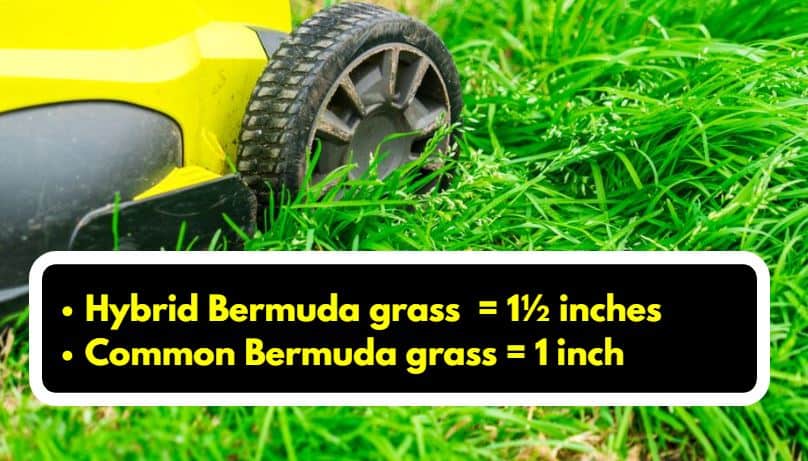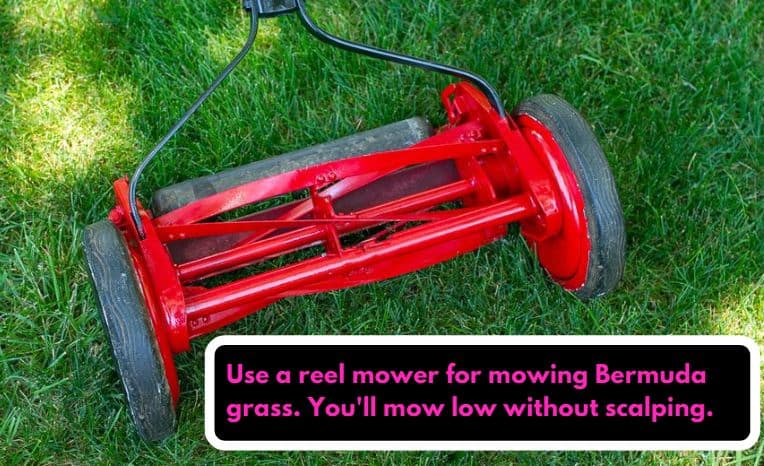Expert Contributors To This Post

Cutting height is important for grass because it directly influences the health, appearance, and resilience of the turf.
The recommended Bermuda grass mowing height is 1.5 inches for hybrid varieties and 1 inch for common varieties. You might, however, need to adjust the frequency and height depending on the season and type of Bermuda grass you’ve grown on your lawn to maximize growth, health, and thickness.
Here’s a complete guide on the height of cutting this grass lawn during different seasons and for different purposes.
What is the best mowing height for Bermuda grass?
The best mowing height for Bermuda grass depends on the variety that you’ve grown on your lawn starting from 5⁄8 to 21⁄2 inches. Unlike common Bermuda grass which has an inch-long stem, hybrid Bermuda grass varieties have been cross-bred to have shorter stems and low-lying crowns.

As such, these hybrid varieties are best mowed when they’re about two inches long. This allows you to mow at about one-and-a-half inches and still maintain dense, lush green Bermuda foliage.
- Hybrid Bermuda grass mowing height = 1 1/2 inches
- Common Bermuda grass mowing height = 1 inch
Common Bermuda grass – meanwhile – is best mowed at higher heights to avoid cutting off most of the leaf blades and leaving your lawn with an unsightly appearance.
Chris Zeisler from Repair Clinic Tip: Cut no more than one-third of your lawn’s grass blade length in a single mowing. Because grass grows through photosynthesis, taller grass blades mean healthier root systems. Shorter blades are unable to obtain the energy needed. Though you may be tempted to give your lawn a buzz cut to skip mowing, you’ll ultimately negatively impact the health and vibrancy of your lawn.
Best Time to Mow Bermuda Grass
The best time to mow your common Bermudagrass lawn is when the grass reaches a height of about three inches. Therefore- after cutting off one inch (one-third of three inches), you should be left with about two inches of lush green common Bermuda grass.
Mowing frequency/schedule
If you’re working with a recently established Bermuda grass turf and your lawn hasn’t been mowed yet, be sure to wait until the end of winter to undertake your first mowing.
- First mowing for new turf = end of winter
- Second mowing = early to mid-spring (when lawn turns green)
This is when this warm-season grass is still in its dormant stage and has a brownish shade. This initial mowing serves to eliminate the unsightly grass blades that failed to survive the cold season.
The second mowing should then be undertaken as soon as the lawn turns green again, presumably from early to mid-spring.
After the first two mowing sessions, the frequency with which subsequent mowing should be undertaken depends on the mowing height settled upon during the second trim.
For instance, golf greens which are usually mowed at higher heights for a visually appealing final look typically need to be mowed every three days. Home Bermuda grass lawns, on the other hand, should be mowed at least once a week.
Cutting Bermuda grass and Seasons
The frequency and height of mowing your Bermuda grass may alter a bit depending on the season. For example, some seasons will require more frequent cutting while others may need conservative measures.
Here are mowing tips for different seasons of the year:
Spring (March-May)
For Bermuda grass, spring normally is a period of fast and rapid growth. It’s advisable to mow lower than the recommended height at this time of the year, to remove the dead leaf blades left behind from the winter dormancy period.
- For hybrid Bermuda, this should be between 1/2 – 3/2- inches.
- For common Bermuda, this should be between 3/2- 5/2- inches.
Summer June – August
Being that this is typically the warmest season of the year, you should mow your Bermuda grass lawn less frequently during these months; preferably once every week.
You can also increase the mowing height a little bit above the recommended height as leaving behind longer leaf blades helps minimize water evaporation. By August, you should have reduced the frequency of your mowing to only when necessary.
Fall (September – November)
You should continue mowing your Bermuda grass up until the end of fall, albeit less frequently (once a month), since it’s at around this time that such warm-season grasses stop growing.
Your final mowing should be at a height that’s slightly lower than the recommended normal mowing height.
Winter (December – February)
This is usually the dormancy period for Bermuda lawns. You should only continue mowing your Bermuda grass lawn during this dormancy season if the lawn has been overseeded with other types of annual/perennial plants.
How tall does Bermuda grass grow?
If left uncut, Bermuda grass can grow to a height of between 4 – 12 inches, with pointed leaves.
However, leaving your lawn grass to grow to such heights would result in a visually unattractive appearance, hence the need to mow low.
It’s advisable to monitor your Bermuda grass lawn and ensure that it doesn’t grow too tall in between consecutive mowings. A good height at which to maintain your Bermuda turf would be 2 inches long.
Tips for Mowing Bermuda Lawns
Now that you know the best Bermuda grass mowing heights as well as the schedule for different seasons, here are a few tips to keep in mind when trying to achieve a thicker, greener lawn.

- When mowing hybrid Bermuda grass lawns, ensure to do so more frequently (up to three times per week) than you would with common Bermuda varieties, as hybrids typically boast a finer texture.
- If you’re going for a close-cut, you might want to use a reel mower; as these landscaping machines are designed to cut grass blades in a vertical pattern, thereby leaving behind more of the leaf blades to facilitate photosynthesis. What’s more, reel mowers are designed to facilitate close cuts, thereby enabling you to mow low without scalping your turf and leaving brown lawn spots, a problem that’s quite common with traditional lawnmowers.
- After mowing, it’s advisable to leave the clippings behind as they become nutrients for the grass that’s left behind.
- It’s important to note that mowing low means setting a high lawn mower height while mowing high means setting a low lawn mower height.
Recommended read: Best Lawn Mowers for Bermuda Grass
Bermuda grass does great on high-traffic turfs such as athletic fields, golf courses, etc. This is because it does not tear up so fast, and will grow back easily if you take care of it properly.
To grow a thicker lawn, ensure that you mow frequently and at the ideal length to stimulate vertical growth that can cushion it against the impact of traffic.
Hi, Alex Kuritz here. Growing up I remember that my family had one of the best lawns in the neighborhood. Richly green and lush. I did a lot as I grew up in terms of caring and tending for not only my family’s lawn but also my neighbors. I can say I have years of experience, and I am here to share it with you.




Thanks for your post. I have Santa Ana Bermuda at my home in San Diego county, and can generally keep it green all year. As it thatches up, I am curious if I am ok to “scalp” it at some point to get the height under control. As time goes on I am constantly having to mow higher to avoid brown spots. I was thinking maybe in winter, giving it a good low mow, and then a solid shot of nitrogen. Any thoughts?
Hi Chris, thanks for the comment and sorry for the delay in replying. If you scalp it in late summer it should still come back and look great. I’m not sure if in your area the bermuda goes dormant or not but i would wait until spring to give it a low mow and a shot of nitrogen. That will give it the best chance to grow back quickly.